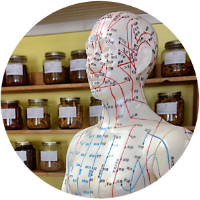Acupressure: A Drug-Free Way
to Relieve Pain and Support Health
Many people are looking for simple, natural ways to care for themselves without always reaching for medication. Acupressure, a hands-on technique based on traditional Chinese medicine (TCM), offers just that... a drug-free alternative for pain relief and daily well-being. By pressing specific points on the body, you can stimulate your own healing responses, calm the mind, and even ease everyday discomforts like headaches, back pain, or indigestion.
Acupressure works on the same principle as acupuncture, using points along the body's meridians, channels where Qi (vital energy) flows. Instead of needles, you use your fingers, thumbs, or knuckles to apply steady, gentle pressure to these points. The goal is to restore balance and promote the smooth flow of Qi, which in TCM is thought to be blocked or stagnant during times of pain or illness.
 Common Points You Can Try Today
Common Points You Can Try Today
Here are a few commonly used acupoints you can press on yourself or a loved one. Each point can be pressed for 1–2 minutes, using firm but comfortable pressure while breathing deeply. Repeat as needed throughout the day.
Hegu (LI4 合谷) — Located on the back of the hand between the thumb and index finger, this is one of the most famous points for pain anywhere in the body. It is especially useful for headaches, neck pain, and even stress relief. (Avoid during pregnancy.)
Neiguan (PC6 内关) — Found about three finger-widths up from the wrist crease on the inside of your forearm, between the two tendons. This point is excellent for calming nausea, motion sickness, and anxiety, as well as easing chest discomfort.
Zusanli (ST36 足三里) — On the front of the lower leg, about four finger-widths below the kneecap and slightly to the outside of the shinbone. This point is often called the "longevity point" because of its wide range of benefits: boosting energy, supporting digestion, and even enhancing immune function.
Taichong (LV3 太冲) — On the top of the foot, in the webbing between the big toe and second toe. This point helps with irritability, stress, menstrual cramps, and digestive issues, especially when caused by emotional tension.
Why Try Acupressure?
Modern research has shown that acupressure can stimulate endorphins, improve circulation, and reduce muscle tension, all of which contribute to pain relief and better overall health. It's a gentle, low-risk way to complement other treatments, and it puts some of your healing power back into your own hands.
You don't need any special tools or training to start practicing acupressure. As you get familiar with the locations and sensations of these points, you'll learn how your body responds. Over time, many people find it becomes a calming daily ritual.
Of course, if you have serious or worsening symptoms, always consult your doctor or a licensed acupuncturist for guidance. But for everyday aches and stress, acupressure is a simple way to care for yourself naturally.
Visit Qi Journal's Interactive Acupoint chart at Acupoint Meridian Explorer
Vocabulary Guide
- Acupressure: The practice of applying pressure to acupuncture points without needles.
- Meridian: Pathways in TCM through which vital energy (qi) flows.
- Qi (氣): Vital energy or life force in TCM.
- Hegu (LI4 合谷): Acupoint on the hand for general pain and headaches.
- Neiguan (PC6 内关): Acupoint on the forearm for nausea and anxiety.
- Zusanli (ST36 足三里): Acupoint on the leg for vitality and digestion.
- Taichong (LV3 太冲): Acupoint on the foot for stress and cramps.
- Acupressure invites you to connect with your body in a quiet, intentional way, and to experience the healing wisdom of Chinese medicine for yourself.







